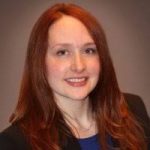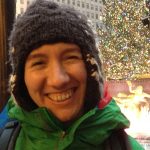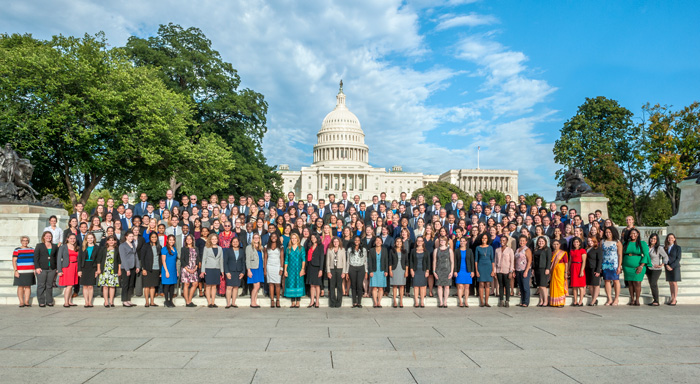This post is part of the Early Career Scientist Policy Subcommittee’s series on science policy fellowships. You can also search for fellowship opportunities in the GSA Policy Fellowship Database.
AAAS Science & Technology Policy Fellowships (STPF) give scientists and engineers the opportunity to apply their knowledge and analytical skills to the policymaking process.

These US-based fellowships are predominantly based within the executive branch of the federal government, for example the National Institutes of Health, although there are several opportunities in the legislative branch working with lawmakers, and one place in the judicial branch.
We spoke to Cara M. Weismann, PhD, a AAAS Science & Technology Policy Fellow, about the application process and her experiences as a fellow.
Q: Tell me about your position.
I am the Special Assistant to the Director of the Division of Policy, Communications, and Education at the National Human Genome Research Institute (NHGRI) at the National Institutes of Health (NIH). I work one-on-one with the Director, Laura Lyman Rodriguez, PhD, who manages a team of approximately 30 people in four branches:
- Policy and Program Analysis Branch
- Education and Community Involvement Branch
- Communications and Public Liaison Branch
- Genomic Healthcare Branch
Q: How would you describe your position?
Having this position is a great opportunity—I get to work with the director constantly. My role includes some ‘gatekeeping’ in terms of scheduling and monitoring information flow to and from the director. It is exciting because I participate in all four branches of NHGRI and gain insight into the role of the branch chiefs and the director in terms of budgeting, planning, and training. I work with a wide variety of people from communications to education and community outreach. I’ve also had the opportunity to further develop leadership skills, for example in designing and leading training sessions.
Q: How much interaction do you have with people outside your division?
My boss is an expert in genomic data sharing and has played a huge role in the genomics data sharing policy, so she is always in demand. This means we communicate with a wide range of parties from program officers, to intramural investigators, to other institutes that work on genomics, and agencies like the FDA and CDC. We also work hand in hand with the NIH Office of Science Policy to achieve many of these goals.
We try to be both proactive and reactive, working to implement the best policy but also getting feedback on how that affects people on the ground. We put out Requests for Comment, hold webinars, and go out into the community to get information and craft policies to better fit people’s experiences.
We also co-sponsor roundtables at the National Academies and I was able to witness the recent Roundtable on Genomics and Precision Health, and Genomics and Population Health Action Collaborative, which brought together people from all over the US, including industry, academia, professional associations, and government agencies.
Q: It sounds like they keep you busy! How do you manage to keep all these projects on track?
It is a lot to fit in, but that is why a team approach is so important. One person can’t do it all alone—plus teams bring additional benefits, such as a range of feedback. It is like being in a lab, you need everyone to give input to get a broad perspective.
Q: What was the application process like?
The application process is intensive and takes many months. The initial application consists of a CV, a short explanation of your extracurricular activities, and a 3000-word essay on why you want to apply for the fellowship and what you hope to achieve. It is imperative to get feedback on your essay from a current or former fellow, because the essay is a unique piece of writing that is unlike anything we have been trained to write as scientists. For example, you have to remember that the people reading your essay may be the ones who crafted the policy, so diplomacy is important. You’d do well to avoid very critical statements of the type one would use to describe scientific data, for example.
Q: What are the next steps in the process?
If successful, you will then be invited to submit a one-page briefing memo on one of three-five science topics that might be in the news. For example, I applied in the 2015-2016 application cycle and I wrote a briefing on Zika virus. You would then have a 30-minute online interview, where you would present your briefing and then answer questions on the briefing and your application materials. Throughout all these steps, it is vital to ensure a consistent message; make sure you can articulate what you bring that is unique, what you will get out of the process, and how the fellowship will shape your future.
The final in-person interviews in DC take place over a week. Agencies can pre-select candidates whom they wish to interview, and when you arrive in DC, you can also schedule interviews with particular agencies and offices who are taking fellows that year. Remember that the interviews are a two-way process; you are also interviewing the agencies to make sure you will thrive. You need to understand what makes you happy: having a direct supervisor that you see every day or having less frequent oversight; working on a distinct project or being open to finding new opportunities; how do you like to receive feedback? The week is also a chance to learn to physically navigate DC and surroundings; you might have meetings at NIH in Maryland in the morning and have to travel to NSF (National Science Foundation) in Virginia in the afternoon.
Q: How did you make the decision to stay for a second year of the fellowship?
Prior to the time that interviews with prospective candidates are being scheduled, your agency has to decide whether you are staying or whether they need to interview for a replacement. In my case, it was easy. My boss and I have regular check-ins and she was happy with me and I was happy to stay! I wanted to develop the work products that I could use as evidence of achievement for my future job search. I also wanted to expand my experience and use the opportunity to achieve things in the field; having a second year gives you multiple opportunities to have an impact. Plus you only have this opportunity to be a AAAS policy fellow once, so I wanted to make the most of it.
Q: Finally, how easy was it to connect with people in DC?
People come to DC thinking that they won’t know anyone, but you have over 200 of your best friends who just moved here too—you just haven’t met them yet! There are many opportunities to build meaningful connections with your colleagues. One avenue is through fellows’ “affinity groups” that are based on shared professional interests, and social groups such as the “food exploration” group that I co-chair. I feel so grateful to be here, and I try to share that experience with as many people as possible.
This post is part of the Early Career Scientist Policy Subcommittee’s series on science policy fellowships.
About the Author:
 Giovanna Collu is co-chair of the Early Career Scientist Policy Committee and a postdoctoral fellow at the Icahn School of Medicine at Mount Sinai. Giovanna’s goal is to increase advocacy opportunities for early career scientists with a focus on diversity and inclusion.
Giovanna Collu is co-chair of the Early Career Scientist Policy Committee and a postdoctoral fellow at the Icahn School of Medicine at Mount Sinai. Giovanna’s goal is to increase advocacy opportunities for early career scientists with a focus on diversity and inclusion.













